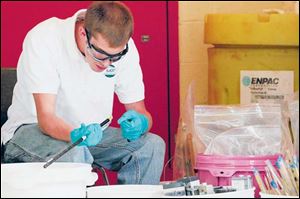
Bowling Green State University program helps people, institutions get rid of mercury
7/5/2008
Teddy Rader of Rader Environmental Services tries to identify mercury in items collected by Bowling Green State University's mercury reclamation program.
BOWLING GREEN - In the last 10 years, David Heinlen and his co-workers have collected more than 11 tons of mercury.
That's 11 Volkswagen Beetles, 22 standard-sized refrigerators, or 4,500 Apple MacBooks.
Mr. Heinlen, director of Bowling Green State University's Elemental Mercury Collection and Reclamation Program, has spent the past decade of his life accumulating thermometers, dental fillings, blood pressure cuffs, thermostats, barometers - whatever contains the faintest drop of that silvery toxin.
"I work with anyone who wants to give me anything," Mr. Heinlen said.
The program was founded in 1998, several years after a staff geologist at the university saw mercury dripping through the ceiling of his laboratory while the floors above him were being renovated.
After the area was sealed off, Mr. Heinlen began an initiative to minimize amounts of mercury at the university. The program soon expanded to cover all of Wood County, and now accepts mercury-containing items from all over the country.
Mercury is a naturally occurring element commonly used in scientific and medical devices because it registers temperature and pressure with great accuracy. But elemental mercury also releases vapors invisible to the naked eye that act as a neurotoxin when inhaled.
The Web site for Bowling Green's environmental health and safety department includes a video of mercury vapors - lit with ultraviolet bulbs against a fluorescent background - curling upwards like a thin trail of smoke.
"The best way to handle mercury is to get it out of the hands of residents and out of public buildings," said Mike Gerber, emergency response on-scene coordinator for the Ohio Environmental Protection Agency. "Bowling Green is one of the few schools in the country that is doing this."
The program has received recognition from the United States Environmental Protection Agency and the National Safety Council for continuously exceeding its goals for mercury collection.
Most recently, the program set a goal to accumulate 3,750 pounds of mercury from July 1 of last year to Sept. 1 of this year.
"We're almost there, and that's amazing," said Mr. Heinlen. "I never thought we'd be able to do it."
The program relies on donations from for-profit entities, but has no "real funding," Mr. Heinlen said.
Mr. Heinlen collects hazardous materials from businesses, hospitals, schools, and individuals, which are safely packaged and taken to Rader Environmental Services in Findlay for processing. The mercury is then sent out of state to be recycled.
"This is one of the only programs that runs this way," said Joe Rader, owner of Rader Environmental Services. "It's free, we don't get reimbursed for our time, it's all volunteer."
It's also convenient: Mr. Heinlen and Mr. Rader often drive out to pick up larger amounts of mercury rather than having people risk exposure by transporting materials themselves.
With the program's help, St. Charles Mercy Hospital in Oregon has decreased the amount of mercury on its premises significantly over the past few years.
In December, 2001, Mr. Heinlen collected 91 pounds of mercury from the hospital. As of 2007, this number had decreased to 3 pounds a year.
Prior to Bowling Green's involvement, the hospital had a local contractor dispose of the materials, which cost $3,000 for 71 pounds of mercury.
"I think the success of the program is word of mouth and the fact that it's free," said Rose Heard, safety coordinator at St. Charles Mercy.
A decade after Bowling Green's hazardous waste storage facility was first filled with heaps of thermometers, barometers, and thermostats, the project has expanded far beyond what Mr. Heinlen ever expected.
"With the amount of mercury we've taken in, hopefully that's resulted in a lot less headache and heartache and exposure and costs of having to clean it up," Mr. Heinlen said. "If we're successful in doing that, that's the overall plus of the program."
Contact Laura Bennett at:
lbennett@theblade.com
or 419-724-6728.